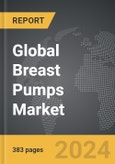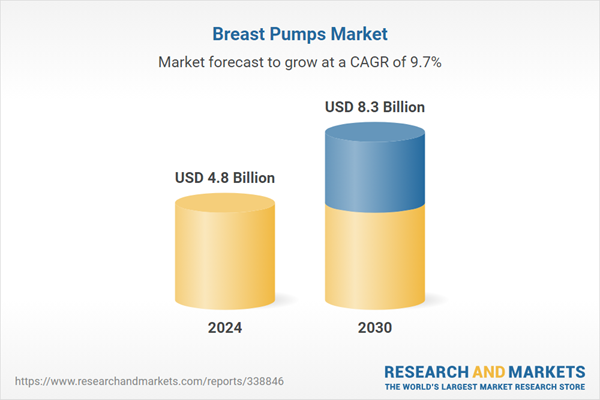The global market for Breast Pumps was valued at US$4.8 Billion in 2024 and is projected to reach US$8.3 Billion by 2030, growing at a CAGR of 9.7% from 2024 to 2030. This comprehensive report provides an in-depth analysis of market trends, drivers, and forecasts, helping you make informed business decisions. The report includes the most recent global tariff developments and how they impact the Breast Pumps market.
In addition, rising medical needs have also led to increased demand. Preterm births and other conditions that prevent direct breastfeeding make breast pumps essential for mothers to ensure their babies receive proper nutrition. Moreover, modern lifestyle changes are driving a shift toward convenient and portable solutions. Lightweight, rechargeable, and wearable pumps cater to mothers who need discreet and efficient pumping while traveling or at work. The rise of e-commerce and online distribution channels has also transformed the industry. E-commerce platforms provide easy access to various brands and models, with comprehensive information helping consumers compare and select products.
Technological advancements have also played a pivotal role in boosting this market. Innovations such as wearable, hands-free models and improved suction mechanisms have made breast pumps quieter, more efficient, and comfortable. Smart pumps that connect to apps are gaining popularity, offering mothers real-time data and helpful reminders. These pumps connect to smartphone apps, allowing users to monitor milk expression in real-time, track sessions, and adjust settings remotely. Features like memory modes enable mothers to record and replicate preferred pumping patterns, while customizable suction strengths and massage modes add a layer of personalization that mimics natural feeding patterns more closely. The move toward more portable breast pumps has been largely driven by the necessity for mothers to multitask and maintain mobility while pumping.
Manufacturers are focusing on comfort and customization by offering customizable suction levels and ergonomic designs to reduce discomfort.
Segments: Product Segment (Battery Powered, Electric Powered, Manual).
Geographic Regions/Countries: World; United States; Canada; Japan; China; Europe (France; Germany; Italy; United Kingdom; and Rest of Europe); Asia-Pacific; Rest of World.
The analysts continuously track trade developments worldwide, drawing insights from leading global economists and over 200 industry and policy institutions, including think tanks, trade organizations, and national economic advisory bodies. This intelligence is integrated into forecasting models to provide timely, data-driven analysis of emerging risks and opportunities.
Global Breast Pumps Market - Key Trends and drivers Summarized
Breast pumps have seen a remarkable evolution over the years, reflecting broader changes in societal attitudes towards breastfeeding and the growing demands of modern parenting. The breast pump market is experiencing significant growth due to a variety of factors. A growing awareness of the benefits of breastfeeding has encouraged many healthcare professionals and organizations to promote it actively, leading to more women seeking solutions that simplify the process, particularly working mothers or those with demanding schedules. As workforce participation among women increases, there is a greater need for convenient breast milk extraction methods.In addition, rising medical needs have also led to increased demand. Preterm births and other conditions that prevent direct breastfeeding make breast pumps essential for mothers to ensure their babies receive proper nutrition. Moreover, modern lifestyle changes are driving a shift toward convenient and portable solutions. Lightweight, rechargeable, and wearable pumps cater to mothers who need discreet and efficient pumping while traveling or at work. The rise of e-commerce and online distribution channels has also transformed the industry. E-commerce platforms provide easy access to various brands and models, with comprehensive information helping consumers compare and select products.
Technological advancements have also played a pivotal role in boosting this market. Innovations such as wearable, hands-free models and improved suction mechanisms have made breast pumps quieter, more efficient, and comfortable. Smart pumps that connect to apps are gaining popularity, offering mothers real-time data and helpful reminders. These pumps connect to smartphone apps, allowing users to monitor milk expression in real-time, track sessions, and adjust settings remotely. Features like memory modes enable mothers to record and replicate preferred pumping patterns, while customizable suction strengths and massage modes add a layer of personalization that mimics natural feeding patterns more closely. The move toward more portable breast pumps has been largely driven by the necessity for mothers to multitask and maintain mobility while pumping.
Manufacturers are focusing on comfort and customization by offering customizable suction levels and ergonomic designs to reduce discomfort.
Report Scope
The report analyzes the Breast Pumps market, presented in terms of units. The analysis covers the key segments and geographic regions outlined below.Segments: Product Segment (Battery Powered, Electric Powered, Manual).
Geographic Regions/Countries: World; United States; Canada; Japan; China; Europe (France; Germany; Italy; United Kingdom; and Rest of Europe); Asia-Pacific; Rest of World.
Key Insights:
- Market Growth: Understand the significant growth trajectory of the Battery Powered segment, which is expected to reach US$3.9 Billion by 2030 with a CAGR of a 8.8%. The Electric Powered segment is also set to grow at 11.8% CAGR over the analysis period.
- Regional Analysis: Gain insights into the U.S. market, valued at $1.3 Billion in 2024, and China, forecasted to grow at an impressive 9.1% CAGR to reach $1.3 Billion by 2030. Discover growth trends in other key regions, including Japan, Canada, Germany, and the Asia-Pacific.
Why You Should Buy This Report:
- Detailed Market Analysis: Access a thorough analysis of the Global Breast Pumps Market, covering all major geographic regions and market segments.
- Competitive Insights: Get an overview of the competitive landscape, including the market presence of major players across different geographies.
- Future Trends and Drivers: Understand the key trends and drivers shaping the future of the Global Breast Pumps Market.
- Actionable Insights: Benefit from actionable insights that can help you identify new revenue opportunities and make strategic business decisions.
Key Questions Answered:
- How is the Global Breast Pumps Market expected to evolve by 2030?
- What are the main drivers and restraints affecting the market?
- Which market segments will grow the most over the forecast period?
- How will market shares for different regions and segments change by 2030?
- Who are the leading players in the market, and what are their prospects?
Report Features:
- Comprehensive Market Data: Independent analysis of annual sales and market forecasts in US$ Million from 2024 to 2030.
- In-Depth Regional Analysis: Detailed insights into key markets, including the U.S., China, Japan, Canada, Europe, Asia-Pacific, Latin America, Middle East, and Africa.
- Company Profiles: Coverage of players such as Ameda, Inc., Bailey Medical Engineering, Handi-Craft Company, Hygeia Health, Lansinoh Laboratories Inc. and more.
- Complimentary Updates: Receive free report updates for one year to keep you informed of the latest market developments.
Some of the 257 companies featured in this Breast Pumps market report include:
- Ameda, Inc.
- Bailey Medical Engineering
- Handi-Craft Company
- Hygeia Health
- Lansinoh Laboratories Inc.
- Linco Baby Merchandise Work's Co.,
- Medela
- NUK® USA
- Philips Avent
- TOMY Company Ltd.
Tariff Impact Analysis: Key Insights for 2025
Global tariff negotiations across 180+ countries are reshaping supply chains, costs, and competitiveness. This report reflects the latest developments as of April 2025 and incorporates forward-looking insights into the market outlook.The analysts continuously track trade developments worldwide, drawing insights from leading global economists and over 200 industry and policy institutions, including think tanks, trade organizations, and national economic advisory bodies. This intelligence is integrated into forecasting models to provide timely, data-driven analysis of emerging risks and opportunities.
What’s Included in This Edition:
- Tariff-adjusted market forecasts by region and segment
- Analysis of cost and supply chain implications by sourcing and trade exposure
- Strategic insights into geographic shifts
Buyers receive a free July 2025 update with:
- Finalized tariff impacts and new trade agreement effects
- Updated projections reflecting global sourcing and cost shifts
- Expanded country-specific coverage across the industry
Table of Contents
I. METHODOLOGYII. EXECUTIVE SUMMARY2. FOCUS ON SELECT PLAYERSIII. MARKET ANALYSISIV. COMPETITION
1. MARKET OVERVIEW
3. MARKET TRENDS & DRIVERS
4. GLOBAL MARKET PERSPECTIVE
UNITED STATES
CANADA
JAPAN
CHINA
EUROPE
FRANCE
GERMANY
ITALY
UNITED KINGDOM
REST OF EUROPE
ASIA-PACIFIC
REST OF WORLD
Companies Mentioned (Partial List)
A selection of companies mentioned in this report includes, but is not limited to:
- Ameda, Inc.
- Bailey Medical Engineering
- Handi-Craft Company
- Hygeia Health
- Lansinoh Laboratories Inc.
- Linco Baby Merchandise Work's Co.,
- Medela
- NUK® USA
- Philips Avent
- TOMY Company Ltd.
Table Information
| Report Attribute | Details |
|---|---|
| No. of Pages | 383 |
| Published | April 2025 |
| Forecast Period | 2024 - 2030 |
| Estimated Market Value ( USD | $ 4.8 Billion |
| Forecasted Market Value ( USD | $ 8.3 Billion |
| Compound Annual Growth Rate | 9.7% |
| Regions Covered | Global |









